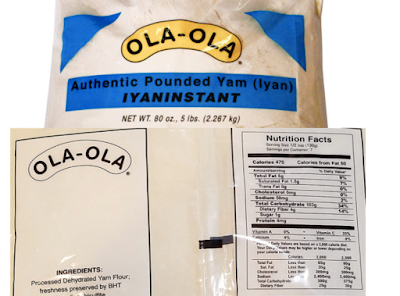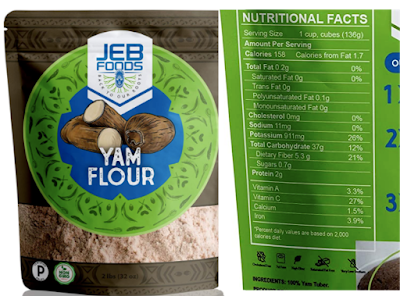WHAT IS FUFU MADE OF?
- Boil water in a pot
- Turn the temperature down to medium low after the water has boiled
- Add the flour and stir vigorously while pounding simultaneously to make the fufu smooth to get rid of lumps
- You can add more water or flour to attain the right texture of the fufu
- Its that simple in modern times!
Fufu/Swallow Eaten In Nigeria
Garri/Eba
Garri or Eba as it is called in parts of Nigeria is made from grated, fermented and dried cassava. The end product is a sort of cassava granule much thicker than flour. There is white garri and yellow garri. Yellow garri has had the addition of palm oil to it during processing giving it's distinctive yellow color. Both types of garri can be used to make eba.
 Eba is probably the most popularly eaten form of fufu(swallow) in Nigeria due to its ease in preparation and cheapness. Unlike most other fufu, you do not need to stir vigorously with a lot of muscle to make eba.
Eba is probably the most popularly eaten form of fufu(swallow) in Nigeria due to its ease in preparation and cheapness. Unlike most other fufu, you do not need to stir vigorously with a lot of muscle to make eba.- boil some water in a kettle,
- pour some dried garri into a bowl or pot.
- Pour the hot water on the garri and stir until it comes together to form a ball.
- You may add more water or garri, depending on the texture you want it.
Below is a picture of fresh cassava tubers. Cassava is also called Yuca in some parts of the world. So if you have ever eaten yuca fries this is what you are eating. Cassava is also used to make tapioca, boba pearls. Many gluten free breads ands and baked goods use cassava flour.
Fufu/Akpu/Lafun
Akpu is made from fresh cassava only. To make cassava fufu from scratch, the cassava is first peeled, chopped, soaked in water to ferment for 3-4 days. After fermentation the cassava is washed strained using a muslin cloth before going through a pounding and double boiling process. If the cassava is not to be cooked right away it can be further processed into flour by allowing it to sun dry very well before grinding. You can see, to make cassava fufu from scratch is a long tedious process.
Pounded Yam/Utara Ji/Iyan
Pounded yam is probably my favorite type of fufu due to its smooth, soft fluffy texture. I find cassava fufu(akpu) to be much more sticky which I don't like. Traditionally to make fufu, yam is peeled, chopped, boiled, and pounded with a large motar and pestle.
It takes a lot of strength and time to pound yam very well. However now with the advent of blenders, this process can be dramatically shortened.For those of you who can not find yam in a grocery store, or who simply don't have the time to make fresh pounded yam, you can buy yam flour online on Amazon. Again, from a nutrition stand point it is always better to eat more less processed foods. So pounded whole yam would be more nutritious than yam flour. Be sure to check the ingredient list when shopping for yam flour. There are some brands on the market that actually contain mostly potato starch. The yam flour I buy if yams are unavailable is Ola Ola which only list 2 ingredients, yam flour and BHT as a preservative.
Amala
Amala is another type of fufu eaten primarily by the Yoruba people of Nigeria. There are 2 main types of amala. amala isu the most popular type is made from yam flour, and amala ogede is made from plantain or plantain flour. Amala made from yam looks unlike other fufu as it is dark brown in color. One would think that in fact it is not made from yam.
To make yam flour the yam is is peeled, sliced and soaked in water over night. The back(skin) of the yam is also included and this is why the flour turns brown when cooking. After the soaking, the yam is washed and cleaned, then spread under the sun to dry. Once the yam is very dry it can then be ground into powder form making yam flour. This flour is called elubo by Yoruba people. Then you simply add the yam flour to boiling water and stir vigorously when making amala.
As you can see from the nutrient labels of both amala varieties this fufu is lower in calories, lower in carbohydrates, and higher in fiber than other fufu varieties, but still low in protein. This makes amala and plantain fufu a better option for people with diabetes. It is still a high calorie and high carbohydrate food so it should still be eaten with extreme moderation if weight loss and diabetes control is your goal.
Semo/Semolina/Semovita/Wheat fufu
Semolina or "Semo" as it is called in Nigeria is a type of flour made from durum wheat. Durum wheat is native to Africa and the middle east and is cultivated extensively in Ethiopia and north Africa. Durum wheat is actually what is used to make couscous. Semolina is essentially couscous flour in a way. Most fufu in Nigeria advertised as "whole wheat," comes from durum wheat. Semolina is coarser than regular white flour, but still fine in texture. In the West and Europe semolina is primarily used to make pasta and pizza dough. Unlike other fufu varieties it is not gluten free as it comes from wheat. Another difference is that it actually is a good source of protein unlike other fufu which have little to no protein. As it is flour it is cooked in the same way as other fufu. Boil water, add the flour, stir vigorously until you get the right consistency and texture you want.
Interestingly, semo is the type of fufu I grew up eating most in Kansas City Missouri as the child of Nigerian immigrants. I presume because it was readily available in grocery stores. If you are looking for semo that is made by Africans for fufu specifically than shopping online on Amazon is a good choice.
Tuwu Shinkafa (rice fufu)
Tuwu Shinkafa is eaten in Northern Nigeria only and it is quite simple to make. Just over boil some rice until it is mushy, and mush it all together. Thats it. It is best not to use parboiled rice to make this, but rather a short grain sticky rice.
Fufu in Ghana, Cameroon, and other West African Countries
In these two countries fufu is typically made from a combination of fermented cassava and corn (Banku) or cassava and plantain. The process of fermentation is the same as done in Nigeria
You can buy Banku mix online on Amazon and surprisingly fully made Banku as well.
Fufu in Kenya, Tanzania, Rwanda, Central and South Africa
Ugali/Nshima/Pap/Upththu ( corn fufu) is the primary fufu eaten in eastern and south Africa. Processing corn to make corn meal for fufu is a tedious process and from my research it seams most people simply buy corn meal flour, commercially sold as maize meal or mealie meal to make ugali. It is prepared the same way as other fufu flours by adding to boiling water and stirring.
Fufu Nutrition/ Is Fufu Healthy?
Fufu should not be classified as an unhealthy food when made from and eaten from the whole vegetable. Cassava, yams, plantains, and corn are all made of complex carbohydrates and minerals, which are a good source of energy. Both cassava and yams are rich in vitamin c, and potassium. Yams are also a good source of zinc and iron (1). Plantains are rich in vitamin C, potassium, magnesium, vitamin B6 and fiber. And corn is rich source of B vitamins and antioxidants.
The issue with eating fufu in excess is that if your daily activity level is low, you will surely gain weight. As mentioned fufu is high in carbohydrates and calories. Carbohydrates are not unhealthy. We all need carbohydrates as it is the primary fuel source our body uses for energy. The issue is the amount of carbohydrate you eat should be matched with your ACTIVITY LEVELS. If you do not burn the carbohydrate off by being active during the day, any excess will be stored as fat in the body. Fufu is a food meant to fill an empty stomach of a farmer, of which traditionally most Africans were. In past most Africans lead very active lifestyles, so there were no issues with eating large amounts of fufu. Now a days most people lead sedentary lifestyles with desk jobs/school and use public or private transportation instead of walking. Also with the advent of using processed flour as fufu, this may increases the likely of developing diabetes. You can read more about diabetes HERE, and how excess consumption of carbohydrates and processed food lead to diabetes HERE.
Low Carb Fufu
With the advent of modern diseases like diabetes and obesity people are looking for different alternatives to enjoy their cultural meals without added weight and/or worsening of disease. For someone to continue consuming fufu on a regular basis in large quantities, without added weight gain, they must lead a VERY active lifestyle like the farmers of yesteryear. For those of you who are unable to increase your activity or decrease the portion size of fufu you eat to help curtail diabetes and obesity low carb options may be your best bet. Low carb options include cauliflower fufu, cabbage fufu, and eggplant fufu. Oat fufu is another option much easier to make than cauliflower and other low carb fufus. Oat fufu is lower in carb than yam and cassava fufu, and much higher in protein and fiber. Because of this it will not spike your blood sugar much when you eat it as it will take the body longer to digest, making it a good option for someone with diabetes. Though it is still higher in carbs than the aforementioned fufu options made from fibrous vegetables, so for weight loss the low carb veggie fufu are the absolute best solution.
The bottom line.
Fufu is healthy, but for weight and disease management, it must be eaten in moderation combined with leading an active lifestyle.
Reference
(2016) Cassava (Manihot esculenta Crantz) and Yam (Dioscorea spp.) Crops and Their Derived Foodstuffs: Safety, Security and Nutritional Value, Critical Reviews in Food Science and Nutrition, 56:16, 2714-2727, DOI: 10.1080/10408398.2014.922045



















1 Comments
D3B5F98733
ReplyDeletekiralık hacker
hacker arıyorum
belek
kadriye
serik